Assessment of Ecological Carrying Capacity in Xilingol League Based on Three-Dimensional Ecological Footprint Model
Abstract
1. Introduction
2. Materials and Methods
2.1. Overview of the Study Area
2.2. Data Source and Processing
2.3. Research Method
2.3.1. Calculating the Ecological Footprint
2.3.2. Calculating Ecological Carrying Capacity
2.3.3. Calculating Ecological Deficit/Surplus
2.3.4. Calculating the Three-Dimensional Ecological Footprint
2.3.5. Ecological Pressure Index
2.3.6. Two-Factor ANOVA
2.3.7. M-K Mutation Test Method
3. Results
3.1. Ecological Footprint Analysis
3.1.1. Changes in Ecological Footprint Across Banners and Counties
3.1.2. Changes in Ecological Footprint by Land Use Type
3.2. Ecological Carrying Capacity Analysis
3.2.1. Changes in Ecological Carrying Capacity Across Banners and Counties
3.2.2. Changes in Ecological Carrying Capacity by Land Use Type
3.3. Analysis of Ecological Surplus and Deficit Across Banners and Counties
3.3.1. Changes in Ecological Surplus and Deficit Across Banners and Counties
3.3.2. Changes in Ecological Surplus and Deficit by Land Use Type
3.4. Footprint Depth Analysis
3.4.1. Changes in Footprint Depth Across Banners and Counties
3.4.2. Changes in Footprint Depth by Land Use Type
3.5. Ecological Pressure Analysis
3.5.1. Changes in Ecological Pressure Across Banners and Counties
3.5.2. Changes in Ecological Pressure by Land Use Type
3.6. Two-Way ANOVA
3.6.1. Ecological Footprint
3.6.2. Ecological Carrying Capacity
3.6.3. Ecological Surplus/Deficit
3.6.4. Footprint Depth
3.6.5. Ecological Pressure
3.7. M-K Mutation Analysis
3.7.1. Temporal Trend Changes in Ecological Footprint
3.7.2. Temporal Trend Changes in Ecological Carrying Capacity
3.7.3. Temporal Trend Changes in Ecological Surplus/Deficit
3.7.4. Temporal Trend Changes in Footprint Depth
3.7.5. Temporal Trend Changes in Ecological Pressure
4. Discussion
5. Conclusions
Author Contributions
Funding
Institutional Review Board Statement
Informed Consent Statement
Data Availability Statement
Acknowledgments
Conflicts of Interest
References
- Smaal, A.; Prins, T.; Dankers, N. Minimum requirements for modelling bivalve carrying capacity. Aquat. Ecol. 1997, 31, 423–428. [Google Scholar] [CrossRef]
- Qian, X.; Wei, S.; Yili, Z.; Fengyun, M. Research Progress in Ecological Carrying Capacity: Implications, Assessment Methods and Current Focus. J. Resour. Ecol. 2017, 8, 514–525. [Google Scholar] [CrossRef]
- Malthus, T. An Essay on the Principle of Population, 1st ed.; J. Johnson: London, UK, 1798. [Google Scholar]
- Robert, E.P.; Ernest, W.B. Introduction to the Science of Sociology, 1st ed.; The University of Chicago Press: Chicago, IL, USA, 1921. [Google Scholar]
- Rees, W.E. Ecological foot prints and appropriated carrying capacity: What urban economical eaves out. Environ. Urban. 1992, 4, 121–130. [Google Scholar] [CrossRef]
- Wackernagel, M.; Rees, W.E. Perceptual and structural barriers to investing in natural capital: Economics from an ecological footprint perspective. Ecol. Econ. 1997, 20, 3–24. [Google Scholar] [CrossRef]
- Niccolucci, V.; Bastianoni, S.; Tiezzi, E.B.P.; Wackernagel, M.; Marchettini, N. How deep is the footprint? A 3D representation. Ecol. Model. 2009, 220, 2819–2823. [Google Scholar] [CrossRef]
- Fang, K.; Heijungs, R. A Review on Three-Dimensional Ecological Footprint Model for Natural Capital Accounting. Prog. Geogr. 2012, 31, 1700–1707. [Google Scholar]
- Jiao, S.H.; Wang, A.Z.; Chen, L.F.; Zhang, J.W.; Li, Z.X.; Yin, Y.X. Three-dimensional water ecological footprint measurement and its driving factors in China’s provinces. World Reg. Stud. 2022, 31, 988–997. [Google Scholar]
- Lu, Y.; Zhao, Y.D.; Dong, J.H. Ecological security evaluation and driving force analysis of three-dimensional ecological footprint in Northwestern China. Acta Ecol. Sin. 2022, 42, 1354–1367. [Google Scholar]
- Xiong, Y.; Ai, G.X.; Zhou, C.; Yao, Y.; Xie, Q. Temporal and spatial evolution of ecological sustainability in Dongting Lake area based on the improved three-dimensional ecological footprint model. Acta Ecol. Sin. 2022, 42, 1165–1179. [Google Scholar]
- Dai, Y.T.; Zhu, D.L.; Zhang, H.; Guo, L.L. Sustainable Use of Land Natural Capital and Decoupling Effect in Shaanxi Province Based on Three-dimensional Ecological Footprint. Resour. Environ. Yangtze Basin 2022, 31, 1926–1937. [Google Scholar]
- Bi, M.; Yao, C.; Xie, G.; Liu, J.; Qin, K. Improvement and application of the three-dimensional ecological footprint model. Ecol. Indicators 2021, 125, 107480. [Google Scholar] [CrossRef]
- Xun, F.; Hu, Y. Evaluation of ecological sustainability based on a revised three-dimensional ecological footprint model in Shandong Province, China. Sci. Total Environ. 2019, 649, 582–591. [Google Scholar] [CrossRef] [PubMed]
- Zhang, X.X.; Zeng, H. Dynamic of three-dimensional ecological footprint in the Pearl River Delta and its driving factors. Acta Sci. Circumstantiae 2017, 37, 771–778. [Google Scholar]
- Liu, Y.H.; Shi, L.; Chang, H.; Xie, Y.; Wei, L.; Sun, H.L.; Zhai, X. Analysis of driving factors that influence the pattern and quality of the ecosystem in Xilingol League. Acta Prataculturae Sin. 2021, 30, 17–26. [Google Scholar]
- Liu, A.J.; Han, J.G. The Study of Method about Monitoring Grazing Intensity in Xilingol Rangeland Using RS Data. Chin. J. Grassl. 2007, 2, 70–74. [Google Scholar]
- Li, H.; Zhang, L.; Qin, X.; Wang, G.; Meng, X.; Gao, K.; Zhang, J.; Zhang, B.; Guo, J.; Lu, Z. Assessment of regional ecological carrying capacity of the coal-electricity development area in arid and semi-arid grassland of Inner Mongolia. Chin. J. Ecol. 2024, 43, 522–532. [Google Scholar]
- Bao, R.; Qiu, S.; Tang, M.; Deng, H. Evaluation of Ecological Carrying Capacity in Xilingol League Based on DPSIR Model. Ecol. Econ. 2020, 36, 139–145. [Google Scholar]
- Aodenggaowa, M. Changes in Carrying Capacity of Grassland in Xilingol League of Inner Mongolia from 2013 to 2020. Bull. Soil Water Conserv. 2024, 44, 446–454. [Google Scholar]
- Wang, S.; Huang, L.; Xu, X.; Li, J. Evaluation of soil, water resources and ecological carrying status of the Tarim River basin from the perspective of three-dimensional ecological footprint model. Environ. Eng. 2022, 40, 286–294. [Google Scholar]
- Wackernagel, M.; Onisto, L.; Bello, P.; Linares, A.C.; Falfán, I.S.L.; García, J.M.; Guerrero, A.I.S.; Guerrero, M.G.S. National natural capital accounting with the ecological footprint concept. Ecol. Econ. 1999, 29, 375–390. [Google Scholar] [CrossRef]
- Li, Y.F.; Chen, Z.; Lei, H.L.; Liu, C.; Lu, Y.R. Spatial-temporal evolution and ecological sustainability analysis of ecological footprint in Heilongjiang Province. J. Environ. Eng. Technol. 2023, 13, 1194–1203. [Google Scholar]
- Siche, R.; Pereira, L.; Agostinho, F.; Ortega, E. Convergence of ecological footprint and emergy analysis as a sustainability indicator of countries: Peru as case study. Commun. Nonlinear Sci. Numer. Simul. 2010, 15, 3182–3192. [Google Scholar] [CrossRef]
- Wei, B.H.; Kasimu, A.; Reheman, R.; Zhao, Y.Y. Ecological carrying capacity evolution and ecological sensitivity analysis of urban agglomeration in the northern slope of Tianshan Mountains. Acta Ecol. Sin. 2023, 43, 1399–1411. [Google Scholar]
- Liu, H.B.; Xia, C.Z.; Lin, T.; Xu, H.; Lian, S.M.; Xu, Z.L. Sustainable development evaluation based on an improved ecological footprint model: A case study of northern Xinjiang. Acta Ecol. Sin. 2023, 43, 234–248. [Google Scholar]
- Cui, X.R.; Li, X.X.; Zhang, H.M.; Zhang, N.Y.; Feng, Z. Dynamic evaluation of natural capital in Zhejiang Province based on the three-dimensional ecological footprint extension model. Chin. J. Ecol. 2019, 38, 2177–2183. [Google Scholar]
- Fang, K.; Gao, K.; Li, C.H. International comparison of natural capital use: A three-dimensional model optimization of ecological footprint. Geogr. Res. 2013, 32, 1657–1667. [Google Scholar]
- Fang, K. Assessing the natural capital use of eleven nations: An application of a revised three-dimensional model of ecological footprint. Acta Ecol. Sin. 2015, 35, 3766–3777. [Google Scholar]
- Fang, K. Ecological footprint depth and size: New indicators for a 3D model. Acta Ecol. Sin. 2013, 33, 267–274. [Google Scholar] [CrossRef]
- Zhao, X.G.; Ma, C.H.; Gao, L.F.; Wei, L.H. Assessment of ecological safety under different scales based on ecological tension index. Chin. J. Eco-Agric. 2007, 15, 135–138. [Google Scholar]
- Ma, C.X.; Yang, R.X.; Ke, X.L.; Ma, Z. Construction and optimization of ecological security pattern in Yangtze River delta based on the perspective of ecological pressure. Resour. Environ. Yangtze Basin 2022, 31, 135–147. [Google Scholar]
- Xu, D.; Feng, C.H. The statistical analysis of employment structure and its influencing factors based on Two-way ANOVA. Mod. Econ. Inf. 2014, 9, 88. [Google Scholar]
- Wang, C.Y.; Gong, W.; Chang, P.B. Analysis of radiation characteristics of Yan ’an station in 30 years based on MK test. Shaanxi Water Resour. 2022, 10, 184–185. [Google Scholar]
- Lan, X.C. Influence of Mass Elevation Effect Factors on Latent and Sensible Heat Fluxes on the Tibetan Plateau. Master’s Thesis, Henan University, Zhengzhou, China, 2023. [Google Scholar]
- Zhang, H.B.; Wang, W.; Song, Y.J.; Miao, L.G.; Ma, C. Ecological index evaluation of arid inflow area based on the modified remote sensing ecological index: A case study of Tabu River Basin at the northern foot of the Yin Mountains. Acta Ecol. Sin. 2024, 44, 523–543. [Google Scholar]
- Zambrano-Monserrate, M.A.; Ruano, M.A.; Ormeño-Candelario, V.; Sanchez-Loor, D.A. Global ecological footprint and spatial dependence between countries. J. Environ. Manag. 2020, 272, 111069. [Google Scholar] [CrossRef] [PubMed]
- Wu, S.; Gao, X.; Lei, J.; Zhou, N.; Guo, Z.; Shang, B. Ecological environment quality evaluation of the Sahel region in Africa based on remote sensing ecological index. J. Arid Land 2022, 1, 14–33. [Google Scholar] [CrossRef]
- Modernel, P.; Rossing, W.A.; Corbeels, M.; Dogliotti, S.; Picasso, V.; Tittonell, P. Land use change and ecosystem service provision in Pampas and Campos grasslands of southern South America. Environ. Res. Lett. 2016, 11, 113002. [Google Scholar] [CrossRef]
- New, T.R. Australian Grasslands—Variety and Extent. In Insect Conservation and Australia’s Grasslands; Springer: Cham, Switzerland, 2019; pp. 37–57. [Google Scholar]
- ‘Reducing Sheep and Increasing Cattle’ Sang the New Pastoral Song of Grassland. Available online: http://grassland.china.com.cn/2019-07/16/content_40828966.html (accessed on 16 July 2019).
- Fang, J.Y.; Bai, Y.F.; Li, L.H.; Jiang, G.M.; Huang, J.H.; Huang, Z.Y.; Zhang, W.H.; Gao, S.Q. Scientific basis and practical ways for sustainable development of China’s pasture regions. Chin. Sci. Bull. 2016, 61, 155–164. [Google Scholar]
- Tana. Evaluation and cause analysis of grassland ecological deficit—A case study of Xinlin Gol League. J. Anhui Agric. Sci. 2024, 52, 247–249. [Google Scholar]
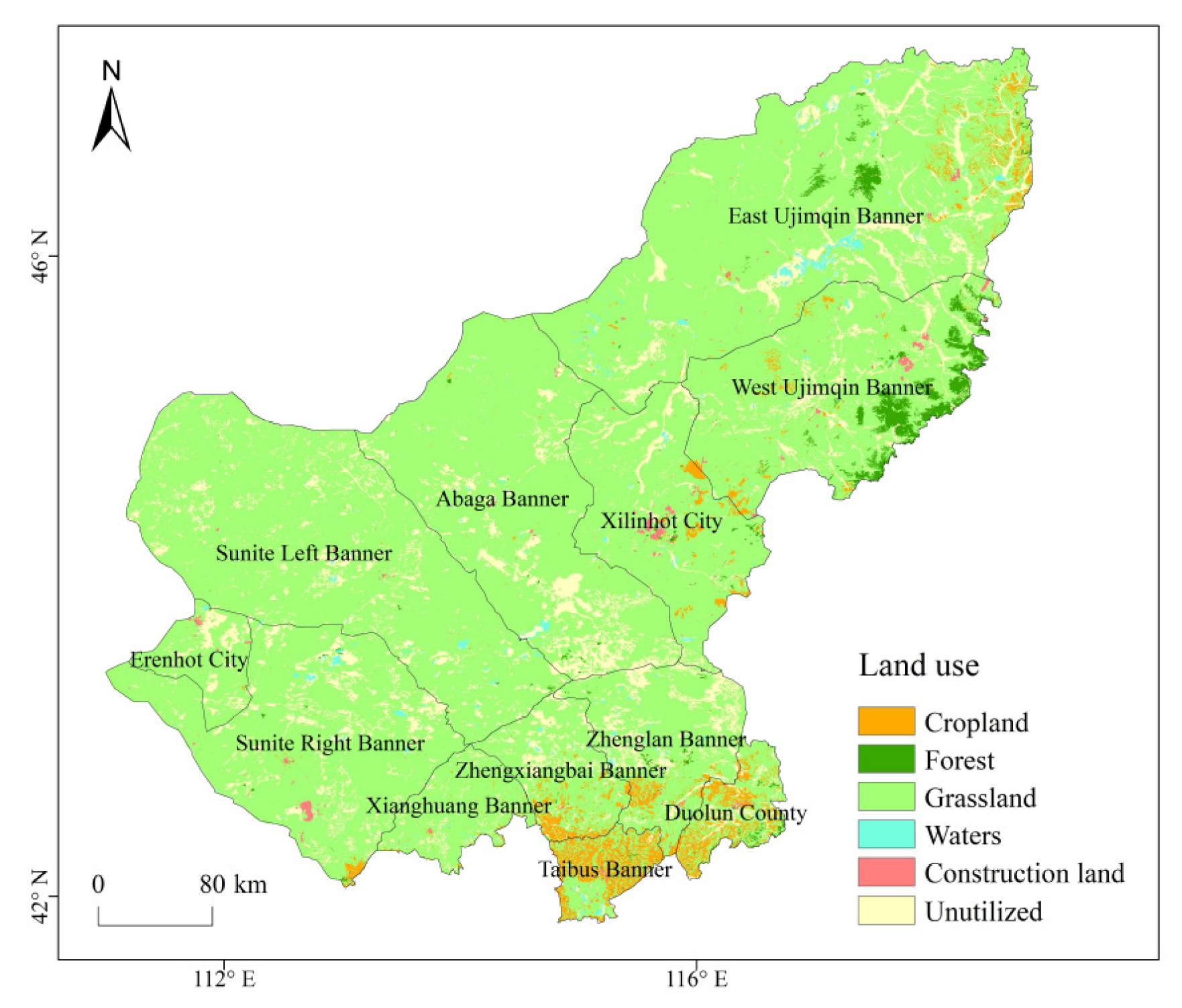
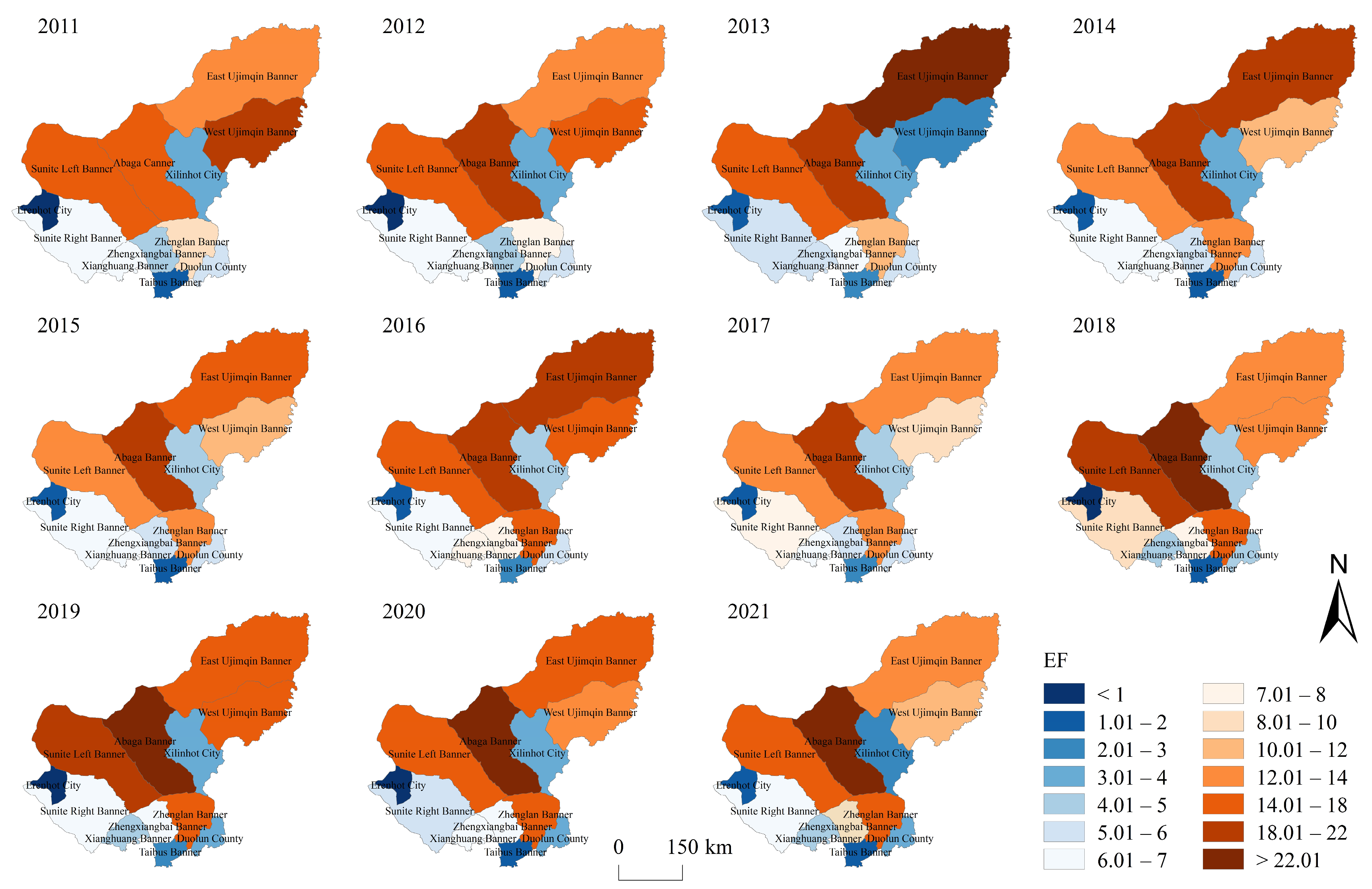


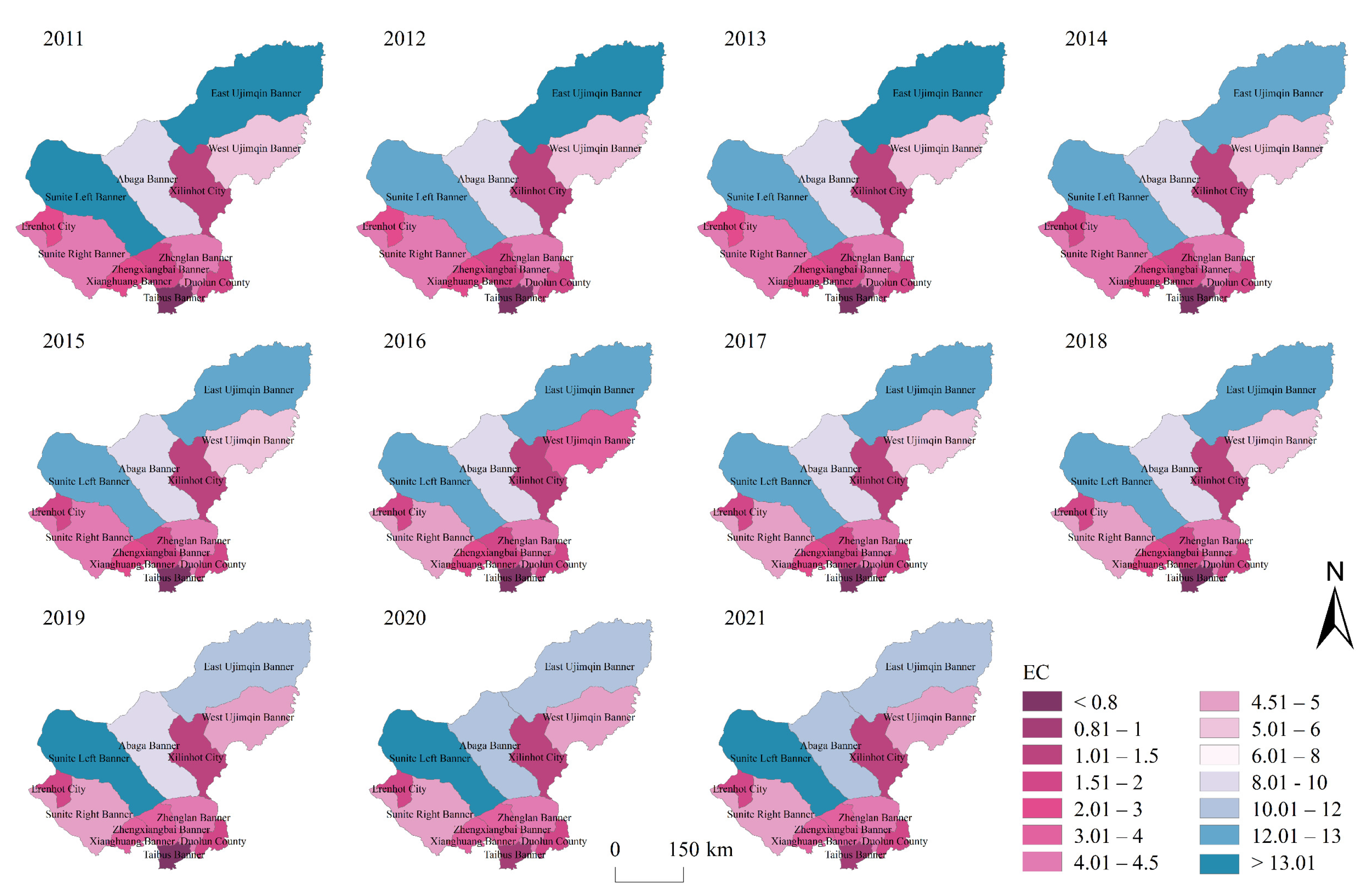
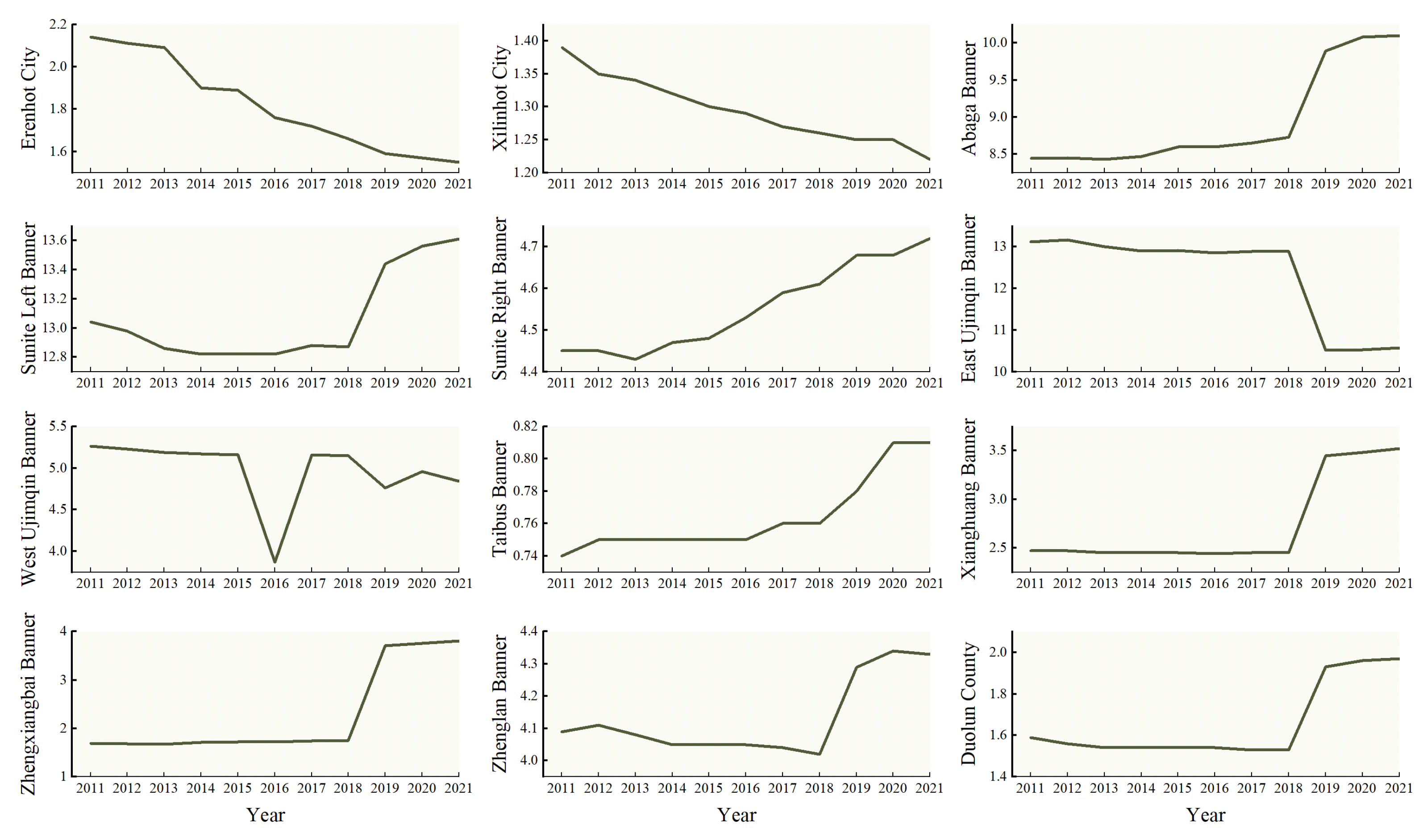

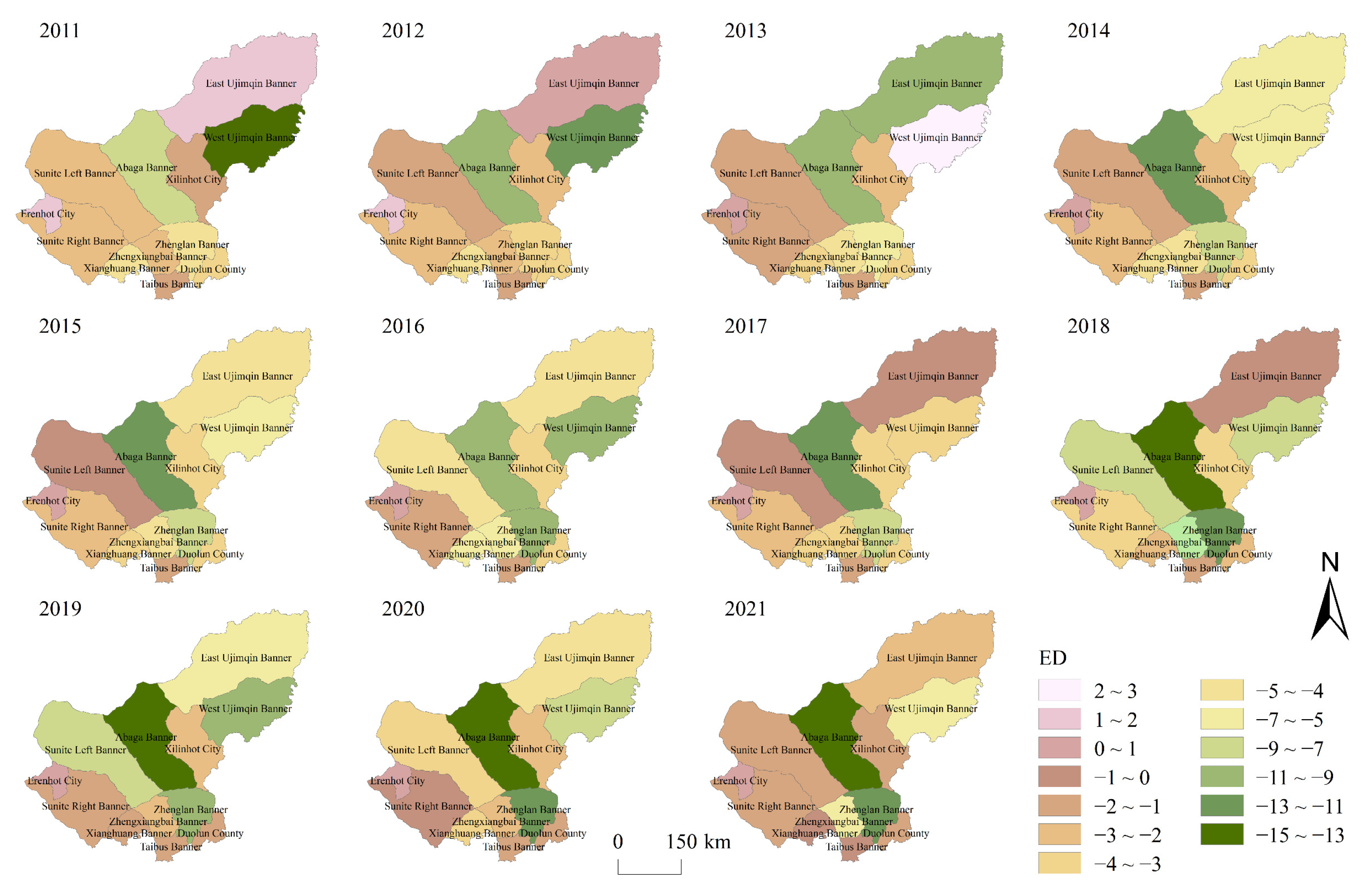
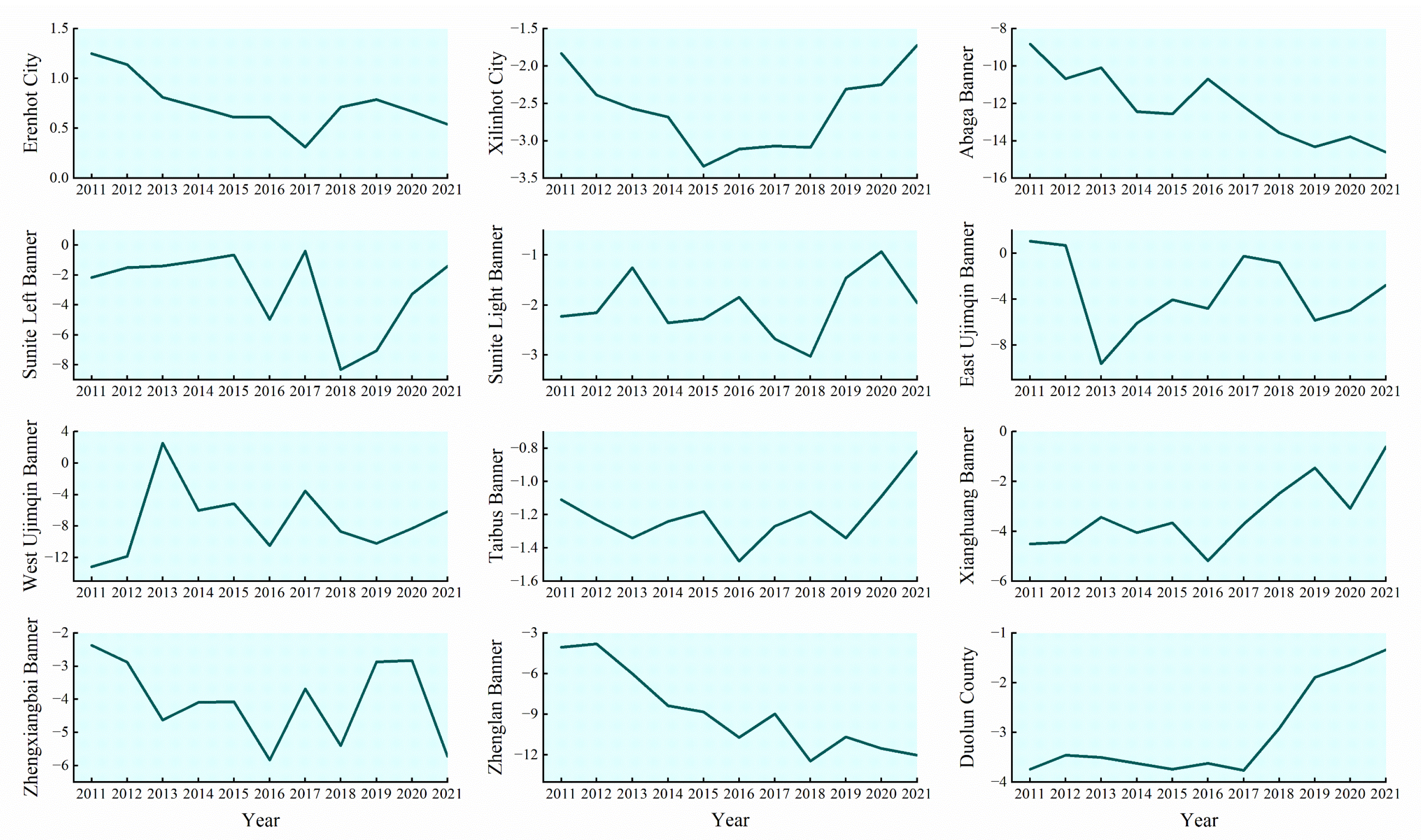





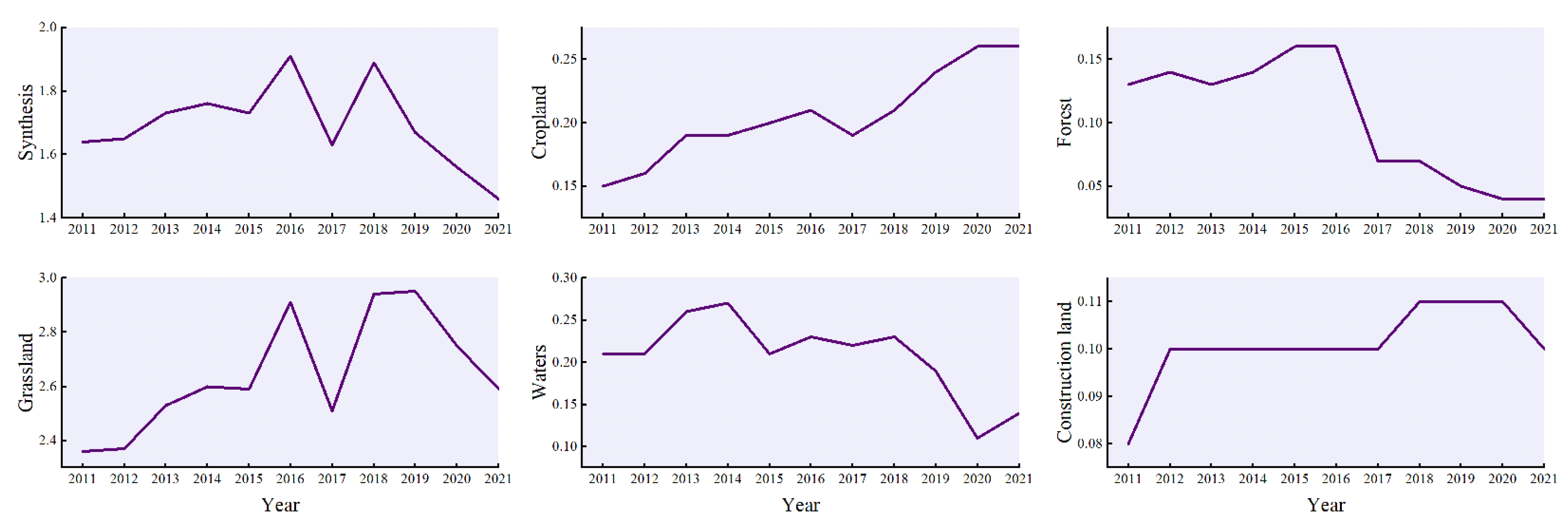
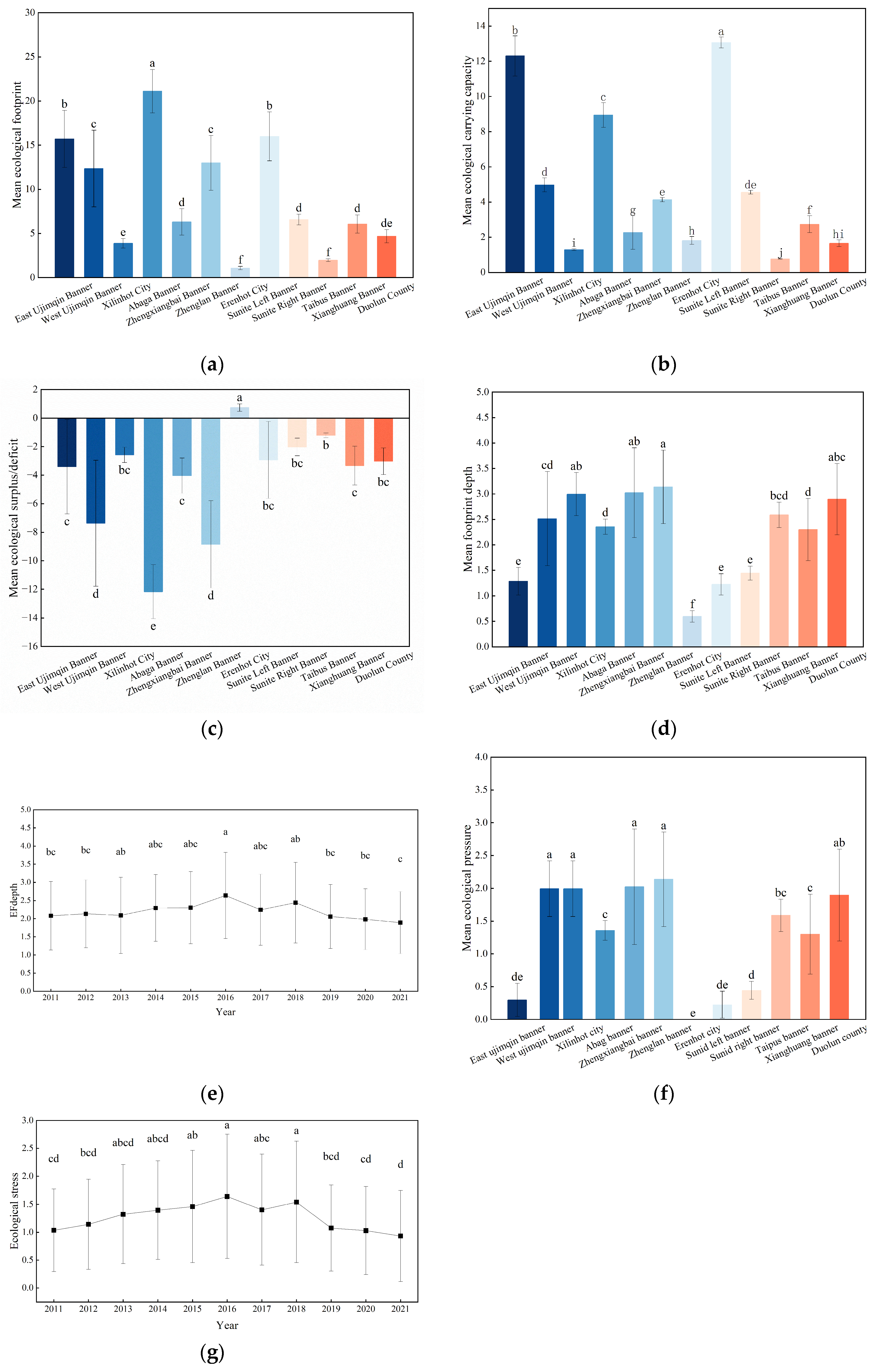

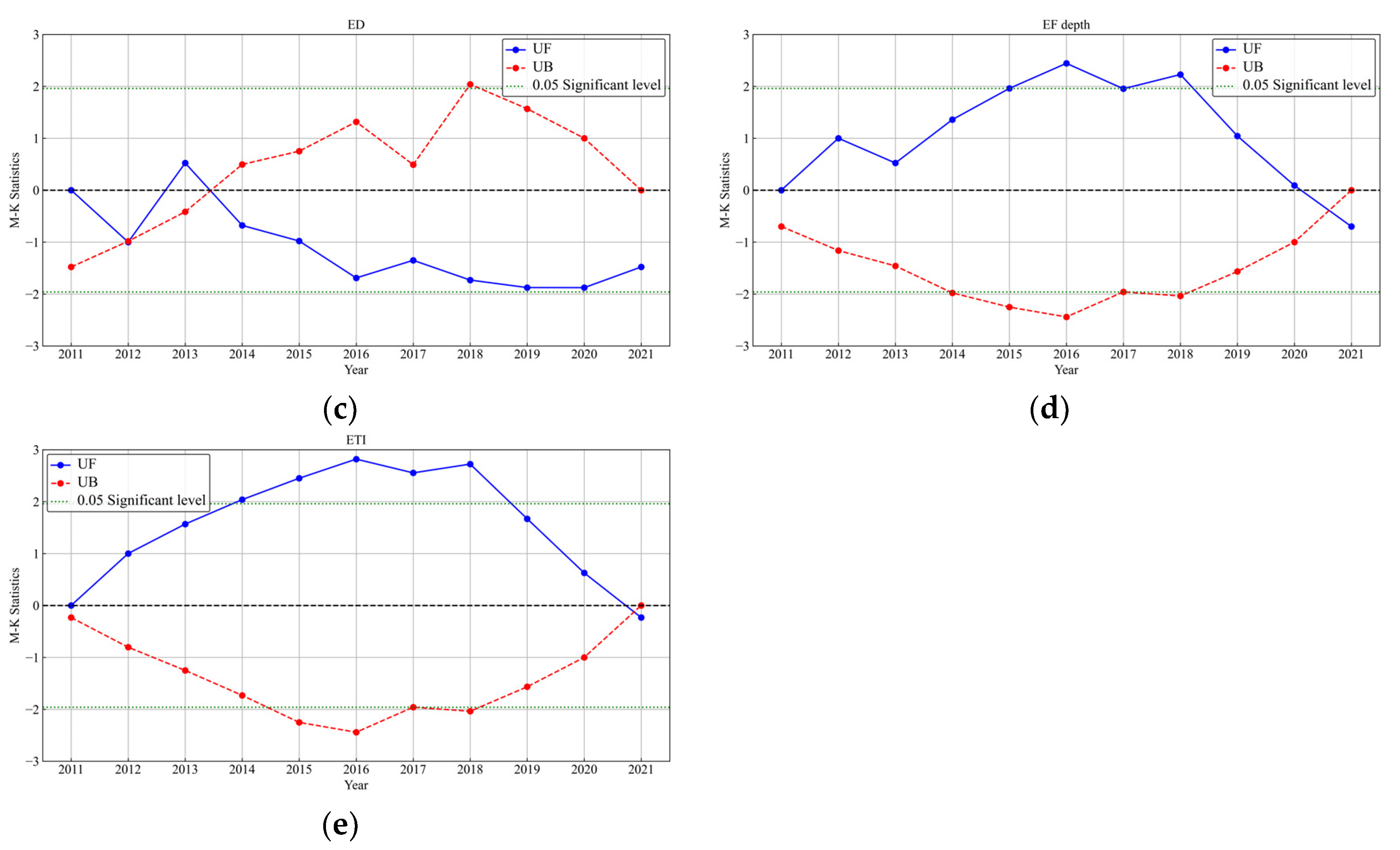
| Account Type | Types of Land for Biological Production | Types of Consumption Items |
|---|---|---|
| Biological resource accounts | Cropland | Eggs, oilseeds, and pork |
| Forest | Vegetables and fruits | |
| Grassland | Beef, mutton, dairy products, and poultry meat | |
| Energy resource accounts | Energy land | Crude oil, gasoline, diesel, and liquefied gas |
| Construction land | Electricity |
| Type | Cropland | Forest | Grassland | Waters | Energy Land | Construction Land |
|---|---|---|---|---|---|---|
| Equilibrium factor | 1.50 | 1.59 | 0.79 | 0.62 | 1.59 | 1.50 |
| Yield factor | 0.52 | 0.68 | 1.07 | 1.07 | 0.00 | 0.52 |
| Ecological Safety Level | Ecological Pressure Index Range | Extent |
|---|---|---|
| I | <0.5 | Very safe |
| II | 0.51~0.80 | Relatively safe |
| III | 0.81~1.00 | Slightly unsafe |
| IV | 1.01~1.50 | Moderately unsafe |
| V | 1.51~2.00 | Highly unsafe |
| VI | >2 | Severely unsafe |
| Indicator | Type III Sum of Squares | Degrees of Freedom | Mean Square | F-Value | p-Value | |
|---|---|---|---|---|---|---|
| Ecological footprint | Intercept | 10,823.804 | 1.000 | 10,823.804 | 2299.701 | 0.000 |
| Banner | 4911.460 | 11.000 | 446.496 | 94.866 | 0.000 | |
| Year | 53.275 | 10.000 | 5.327 | 1.132 | 0.345 | |
| Error | 517.727 | 110.000 | 4.707 | |||
| R2 = 0.906 (Adjusted R2 = 0.888) | ||||||
| Ecological carrying capacity | Intercept | 3138.623 | 1.000 | 3138.623 | 11,115.042 | 0.000 |
| Banner | 2203.146 | 11.000 | 200.286 | 709.288 | 0.000 | |
| Year | 2.037 | 10.000 | 0.204 | 0.722 | 0.703 | |
| Error | 31.061 | 110.000 | 0.282 | |||
| R2 = 0.986 (Adjusted R2 = 0.983) | ||||||
| Ecological surplus/deficit | Intercept | 2306.022 | 1.000 | 2306.022 | 502.367 | 0.000 |
| Banner | 1542.429 | 11.000 | 140.221 | 30.547 | 0.000 | |
| Year | 51.881 | 10.000 | 5.188 | 1.130 | 0.346 | |
| Error | 504.934 | 110.000 | 4.590 | |||
| R2 = 0.759 (Adjusted R2 = 0.714) | ||||||
| Footprint depth | Intercept | 636.462 | 1.000 | 636.462 | 2440.530 | 0.000 |
| Banner | 86.789 | 11.000 | 7.890 | 30.254 | 0.000 | |
| Year | 5.573 | 10.000 | 0.557 | 2.137 | 0.027 | |
| Error | 28.687 | 110.000 | 0.261 | |||
| R2 = 0.763 (Adjusted R2 = 0.718) | ||||||
| Ecological pressure | Intercept | 213.116 | 1.000 | 213.116 | 1143.674 | 0.000 |
| Banner | 79.250 | 11.000 | 7.205 | 38.663 | 0.000 | |
| Year | 6.764 | 10.000 | 0.676 | 3.630 | 0.000 | |
| Error | 20.498 | 110.000 | 0.186 | |||
| R2 = 0.808 (Adjusted R2 = 0.771) | ||||||
Disclaimer/Publisher’s Note: The statements, opinions and data contained in all publications are solely those of the individual author(s) and contributor(s) and not of MDPI and/or the editor(s). MDPI and/or the editor(s) disclaim responsibility for any injury to people or property resulting from any ideas, methods, instructions or products referred to in the content. |
© 2024 by the authors. Licensee MDPI, Basel, Switzerland. This article is an open access article distributed under the terms and conditions of the Creative Commons Attribution (CC BY) license (https://creativecommons.org/licenses/by/4.0/).
Share and Cite
Wu, J.; Yang, X. Assessment of Ecological Carrying Capacity in Xilingol League Based on Three-Dimensional Ecological Footprint Model. Sustainability 2025, 17, 128. https://doi.org/10.3390/su17010128
Wu J, Yang X. Assessment of Ecological Carrying Capacity in Xilingol League Based on Three-Dimensional Ecological Footprint Model. Sustainability. 2025; 17(1):128. https://doi.org/10.3390/su17010128
Chicago/Turabian StyleWu, Jimuji, and Xia Yang. 2025. "Assessment of Ecological Carrying Capacity in Xilingol League Based on Three-Dimensional Ecological Footprint Model" Sustainability 17, no. 1: 128. https://doi.org/10.3390/su17010128
APA StyleWu, J., & Yang, X. (2025). Assessment of Ecological Carrying Capacity in Xilingol League Based on Three-Dimensional Ecological Footprint Model. Sustainability, 17(1), 128. https://doi.org/10.3390/su17010128






